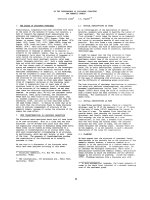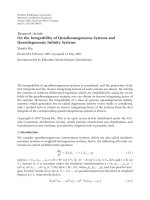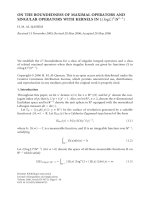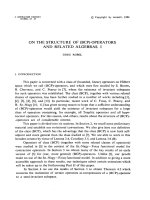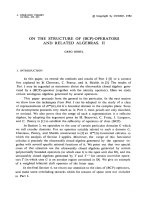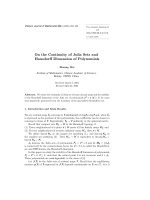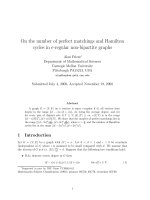wishes on the occasion of birthday, wedding and new year's holiday (or christmas) in british and vietnamese culture a comparative study = lời cầu chúc nhân dịp sinh nhật, cưới hỏi và lễ năm mới
Bạn đang xem bản rút gọn của tài liệu. Xem và tải ngay bản đầy đủ của tài liệu tại đây (869.87 KB, 56 trang )
VIETNAM NATIONAL UNIVERSITY, HA NOI
UNIVERSITY OF LANGUAGES AND INTERNATIONAL STUDIES
FACULTY OF POST – GRADUATE STUDIES
PHẠM THỊ ANH ĐÀO
WISHES ON THE OCCASION OF BIRTHDAY, WEDDING AND NEW
YEAR’S HOLIDAY (OR CHRISTMAS) IN BRITISH AND
VIETNAMESE CULTURE: A COMPARATIVE STUDY.
(LỜI CẦU CHÚC NHÂN DỊP SINH NHẬT, CƯỚI HỎI VÀ LỄ NĂM MỚI (HOẶC
GIÁNG SINH) TRONG VĂN HÓA VIỆT VÀ ANH: MỘT NGHIÊN CỨU SO SÁNH).
M. A. Minor Programme Thesis
Field: English Linguistics
Field Code: 60 22 15
HA NOI - 2010
VIETNAM NATIONAL UNIVERSITY, HA NOI
UNIVERSITY OF LANGUAGES AND INTERNATIONAL STUDIES
FACULTY OF POST – GRADUATE STUDIES
PHẠM THI ANH ĐÀO
WISHES ON THE OCCASION OF BIRTHDAY, WEDDING AND NEW
YEAR’S HOLIDAY (OR CHRISTMAS) IN BRITISH AND
VIETNAMESE CULTURE: A COMPARATIVE STUDY.
(LỜI CẦU CHÚC NHÂN DỊP SINH NHẬT, CƯỚI HỎI VÀ LỄ NĂM MỚI (HOẶC
GIÁNG SINH) TRONG VĂN HÓA VIỆT VÀ ANH: MỘT NGHIÊN CỨU SO SÁNH).
M. A. Minor Programme Thesis
Field: English Linguistics
Field Code: 60 22 15
Supervisor: Assoc. Prof. Dr. Nguyễn Văn Độ
HA NOI - 2010
iv
TABLE OF CONTENTS
PAGE
DECLARATION
i
ACKNOWLEDGEMENTS
ii
ABSTRACT
iii
PART A: INTRODUCTION
1
0.1. Rationale of the study
1
0.2. Aims of the study
1
0.3. Scope of the study
2
0.4. Methods of the study
2
0.5. Design of the study
2
PART B: DEVELOPMENT
3
CHAPTER 1: LITERATURE REVIEW
3
1.1. Speech acts and wishing
3
1.1.1. Speech acts and their classification
3
1.1.2. Wishing as a speech act
6
1.2. Politeness, face and wishing, a face-threatening act
7
1.2.1. Politeness
7
1.2.2. Face
8
1.2.3. Wishing as a face-threatening act
10
1.3. Relationship of language, culture and communication
10
1.3.1. Definition of language
10
1.3.2. Definition of culture
11
1.3.3. Definition of communication
11
1.3 4. Relationship of language, culture and communication
12
1.3.5. Wishing as a need of communication
13
CHAPTER 2: RESEARCH METHODOLOGY
14
2.1. Subject
14
2.2. Instrument of data analysis
14
v
2.3. Methods of data analysis
15
CHAPTER 3: DISCUSSION ON FINDINGS
16
3.1. SURVEY QUESTIONNAIRESAND INFORMANTS
16
3.1.1. Structure of survey questionnaire
16
3.1.2. Grouping of informants
17
3.1.2.1. Age
17
3.1.2.2. Gender
17
3.1.2.3. Living area
18
3.1.2.4. Occupation
18
3.2. VIETNAMESE FINDINGS FROM THE QUESTIONNAIRES
18
3.2.1. Comment on the content of Vietnamese wishes in three situations
18
3.2.1.1. Vietnamese birthday wishes
18
3.2.1.2. Vietnamese wedding wishes
21
3.2.1.3. Vietnamese New Year wishes
24
3.2.2. Comment on priorities in wishing
26
3.2.3. Comment on social factors governing the way of extending a wish
27
3.2.4. Comment on components of the act of Vietnamese wishing
27
3.3. ENGLISH FINDINGS FROM THE QUESTIONNAIRES.
28
3.3.1. Comment on the content of English wishes in three situations
28
3.3.1.1. English birthday wishes.
28
3.3.1.2. English wedding wishes
30
3.3.1.3. English Christmas and New Year wishes
32
3.3.2. Comment on priorities in wishing
33
3.3.3. Comment on social factors governing the way of extending a wish
34
3.3.4. Comment on components of the acts of English wishing
35
3.4. COMPARISON OF THE ENGLISH AND VIETNAMESE WAYS OF WISHING.
35
3.4.1. Major similarities
35
3.4.1.2 Occasions
35
3.4.1.2. Priorities in wishing
35
vi
3.4.1.3. Social factors governing the way of extending a wish
36
3.4.1.4. Accompaniments to wishes
36
3.4.2. Major differences.
36
3.4.2.1. Occasions
36
3.4.2.2. Priorities in wishing
37
3.4.2.3. Social factors governing the way of extending a wish
37
3.4.2.4. Accompaniment to wishes
37
CHAPTER 4: IMPLICATIONS FOR ELT
38
4.1. Learning a culture
38
4.2. Learning to avoid culture shock.
38
4.2.1. Some problems in culture shock.
38
4.2.2. Some potential culture shocks in wishing.
39
PART C: CONCLUSION
41
REFERENCES
42
ENGLISH SURVEY QUESTIONNAIRES
VIETNAMESE SURVEY QUESTIONNAIRES
vii
LISTS OF TABLES
Table 1: Age group correlation between English and Vietnamese respondents
Table 2: Gender correlation between English and Vietnamese respondents
Table 3: Living area correlation between English and Vietnamese respondents
Table 4: Occupation correlation between English and Vietnamese respondents
Table 5: The content of Vietnamese birthday wishes
Table 6: The content of Vietnamese wedding wishes
Table 7: The content of Vietnamese New Year/Christmas wishes
Table 8: Rank of importance of occasions
Table 9: Rank of importance of social factors
Table 10: Components of Vietnamese acts of wishing
Table 11: The content of English birthday wishes
Table 12: The content of English wedding wishes
Table 13: The content of English Christmas and New Year wishes
Table 14: Rank of importance of occasions
Table 15: Rank of importance of social factors
Table 16: Components of English acts of wishing
1
PART A: INTRODUCTION
0. 1. Rationale of the study
English nowadays is considered the international language; it is the most widely spoken
language which is used in many fields such as economics, trade, tourism, diplomacy, politics,
and press. In Vietnam, as a result of the open door economic policy, the number of people
learning English for various purposes is on the rise. English is not only taught as an important
subject at thousands of foreign languages centers but it is also a compulsory subject in various
primary and high schools.
Although English has been taught in Vietnam for many years, not until recently has the
focus of improving linguistic competence for learners been on syntax, lexical and
phonological components of the language. Many people still believe that being good at
English means being good at linguistic components. Thus, cultural factors are paid little
attention to.
However, today, in our modern world in which globalization is expanding, the need of
integrating and communicating across nations is indispensable. Successful communication
requires not only purely linguistic competence but also the knowledge of social norms, social
values and relations between individuals known as communicative competence.
Communicative competence presupposes ability to use the language correctly and
appropriately. This pragmatic competence is as crucial as linguistic competence. The lack of it
may lead to impoliteness, misinterpretation, cultural shocks, and even communication
breakdown.
Hence, the knowledge about cross culture communication is really essential. On this
basis, this study is done to help Vietnamese learners of English to understand English ways of
expressing wishes. The focus of the study will be on similarities and differences between
Vietnamese and English forms of wishing.
0. 2. Aims of the study
The thesis focuses on studying the similarities and differences between English and
Vietnamese ways of wishing in respect to the following aspects:
2
- To investigate the content of expressions used in wishing and non-verbal components
of wishes.
- To find out social factors having influence on extending a wish and some cultural
differences in extending wishes in Vietnam and Britain.
- .To help Vietnamese learners of English have more awareness of English wishing and
of how to use it appropriately.
- To offer some suggestions to ELT (English Language Teaching)
0. 3. Scope of the study
The study mainly focuses on verbal communication and the analysis of the data collected from
the survey questionnaires on extending a wish. Similarities and differences between the
English and the Vietnamese in assessing the interference of social factors in wishing are
discussed. Also some common accompaniments and nonverbal cues together with wishing are
taken into account.
0. 4. Methods of the study
The main method of the study is the quantitative one with techniques:
- Consulting reference books
- Discussing with teachers and friends
- Conducting survey questionnaire
- .Studying relevant publications
- Resorting to personal observation.
0. 5. Design of the study: This study is divided into three main parts:
Part A: Introduction – including the reasons of the study, aims of the study, methods, scope
of the study and the design of the study.
Part B: Development, including 4 chapters
- Chapter 1: Literature review
- Chapter 2: Research methodology
- Chapter 3: Discussion on findings
- Chapter 4: Implications for ELT (English Language Teaching)
Part C: Conclusion
3
PART B: DEVELOPMENT
CHAPTER 1: LITERATURE REVIEW
1.1. Speech acts and wishing
1.1.1. Speech acts and their classification
The concept of speech acts was first developed by Austin in the first edition of the
book “How to do things with words” published in 1962. He did not use the term “speech acts”
but “performative sentence” or performative utterance” which indicated that “the issue of an
utterance is the performing of an utterance” (p6). The term itself was first used by Searle who
claimed that “talking is performing acts according to rules” (p22), and that “speech acts […]
are the basic or minimal units of linguistic communication.” (p16).
According to Yule (1996:47-48), actions performed via utterance are generally called
speech acts and, in English, are commonly given more specific labels such as requesting,
apologizing, offering, etc. The circumstances in which actions are performed to communicate
are generally called speech events – activities in which participants use language to interact in
some conventional way to reach some outcome.
In analyzing a speech act we study how an utterance affects the behaviour of the
Speaker and the Hearer. According to Austin (1962) a speech act consists of three related acts:
- Locutionary act is the actual form of the utterance. When we perform a locutionary
act, we have to produce an utterance of a particular form having a particular meaning and
following the rules of a given language. Yule asserts that a locutionary act is the “basic act of
utterance” and the meaningfulness of linguistic expressions is the determinant of this kind of
act. For example, a sentence “It’s very hot here” can be counted as a locutionary act as it
includes meaningful units of the English language.
- Illocutionary act relates to the concrete purposes of an utterance. This makes
illocutionary acts different from locutionary acts. Thus, uttering the same sentence: “It’s very
hot here”, the speaker does not only utter it but may also suggest a request (e.g. to turn on the
central heating).
4
The illocutionary act is performed via the communicative force of an utterance. When
we utter a sentence, we assign to it the so-called illocutionary force. The illocutionary force
may be understood as some kind of intended message that a speaker assigns to the sentence he
or she utters. As Nguyen Hoa (2001: 151) puts it, “one type of illocutionary force is what is
commonly referred to as implication.” For instance, when we ask someone “Have you got the
time?” the illocutionary force we assign to this utterance seems to be a question about time
rather than whether the addressee has a clock or watch or not.
- Perlocutionary act is the result or affect that speaker can achieve by performing the
locutionary act. According to Mey (1993: 112), these ultimate effects are dependent on the
context of the utterance and are unpredictable. The hearer may correctly understand the
speaker’s intention and do what his/ her interlocutor wants, or the same hearer may
deliberately ignore the speaker’s want or desire. When we utter the sentence “It’s very hot
here”, we hope the act of turning the central heating on to be done by some hearers. This also
means the illocutionary act is performed.
Of these three types of speech acts the illocutionary act appears to be the most crucial
and discussed because the same utterance can potentially have different illocutionary force.
Take the sentence “I’ll be at the office at noon” as an example for this. The locutionary act of
this utterance can be represented as a promise, a threat, a warning or simply a prediction.
Thus, the most useful way to distinguish between these is the attitude that the speaker holds
towards the prepositional content of what he says. However, in order to help hearers really
recognize the intended illocutionary force, two things should be taken into account:
Illocutionary force indicating devices and felicity condition.
* Illocutionary force indicating devices include performative verbs that directly show
the illocutionary acts. However, speakers do not always perform their speech acts explicitly so
Illocutionary force indicating devices that hearers can consider are words, stress, intonation,
voice quality and so on.
* Felicity conditions are expected or appropriate circumstances which speech acts
depend on in order to have effectiveness recognized by hearers. Therefore, the utterance
should be said to right person, in the right place, at the right time with rational behaviour.
5
In spite of those devices, it is not easy for hearers to recognize intended forces of
various utterances. Thus, these forces can be classified into small sets by Searle (1969)
including declaratives, representatives, expressives, directives and commissives.
* Declaratives: speech acts that change the conditions existing in the world via
utterance. In other words, they bring about a new state of being. For example, when the
chairman says “I declare the meeting open”, implied that a change really takes place. People
start to make speeches or address the meeting and so on.
* Representatives: speech acts that state the speaker’s belief in some case. For
example, a sentence like “The earth is flat” is a statement of fact in which the speaker
believes.
* Expressives: speech acts used to express the speaker’s feeling and attitude about
something. They can be statements of joys, disappointment, likes, dislikes such as “what a
great day!”, “Your shirt is very nice”. We can make an expressive in English by using an
exclamation or simply an emotionally charged statement.
* Directives: speech acts used to get the hearer to do something. They are commands,
orders, requests and suggestions. The function of directive may be realized by forms like
imperative sentences, questions or even statement of which illocutionary act is of a directive.
For instance, a sentence “Oh, It stops raining!” is interpreted as a suggestion that let us go out.
* Commissives: speech acts that speakers use to commit themselves to do something in
the future. They function as promises, refusals, threat, pledge, etc. For example, the sentence
“Maybe I can do that tomorrow” shows that the speaker makes a promise of doing something.
It is important to remember that the appropriate forms used for commissives vary according to
social relationship between the participants in a speech event.
There is another approach to speech acts suggested by G. Yule that is made on the
relationship between structure and function of the utterance. When uttering, people can choose
different kinds of structures to show the functions of their utterances depending on certain
communicative purposes. The combination of three structural forms (declarative, interrogative
and imperative) and three general communicative functions (statement, question,
command/request) creates two types of speech acts: direct and indirect.
6
According to G. Yule (1996:55) “coherence there is a direct relationship between a
structure and a function, we have a direct speech act, whenever there is an indirect relationship
between a structure and a function, we have a direct speech act.”
For example, we have two following structures which transfer the same function that
the speaker wants the hearer not to stand in front of the television.
1. Move out of the way
2. You’re standing in front of the TV
Structure
1
(imperative) + Function (command/request) = direct speech
Structure
2
(declarative) + Function (command/request) = indirect speech
In the example, different structures (imperative, declarative) can be used to accomplish
the same function: a command or request, but only the imperative structure represents a direct
speech act and the declarative structure represents an indirect request.
In English, it is observed that indirect speech acts are more polite than direct ones in
performing some kinds of speech acts especially in requesting.
In brief, speech acts are acts performed via utterances which help us understand clearly
“what kind of things we can do with words” as well as identify “some of the conventional
utterance forms we use to perform specific actions” (Yule 1996: 58).
1.1.2. Wishing as a speech act
It is no doubt that wishing becomes a vital need in our daily life, especially on special
occasions such as New Year, birthday, wedding, etc because it helps people convey and
express their feeling and emotion to each other.
Wishing like thanking, promising, inviting, requesting, etc. is known as one of the
most important communicative.
According to Wierzbicka “a wish as a speech act expresses a certain mental wish, but
not just any wish, it must be a wish claimed at something good that would happen to the
addressee” (1987: 227).
Thus, in terms of the speech act theory, wishing is considered to be an act of showing
good feelings towards the addressee through utterance(s). For example, when we utter the
sentence like “I wish you a healthy, joyful and happy future”, we do not only produce a
7
meaningful sentence but we also want to convey our desire to the hearer, and we expect that
our communicative intention will be recognized by the hearer. In other words, a wish may be a
locutionary act, an illocutionary act or a perlocutionary act.
In brief, wishing has all the characteristics of a speech act.
1.2. Politeness, face and wishing – a face threatening act
1.2.1. Politeness
* Politeness is the universal concept of human communication across cultures. It is
also both a communicative and cultural one. Many linguistic researchers have given their own
definitions of politeness, but most of them share the common theme that politeness is a feature
of language use and a pervasive ritual in human social interaction and how language expresses
the social distance between speakers and their different role relationship.
According to George Yule (1996:70):
Politeness, in an interaction, can be defined as the means employed to show awareness
of another person’s face.
In this sense, politeness can be accomplished in situations of social distance or
closeness. Showing awareness for another person’s face when that other seems socially distant
is often described in terms of respect or deference. Moreover, languages differ in how they
express politeness. In English, phrases like I wonder if I could…. can be used to make a
request more polite.
According to Robin Lakoff (1990:38):
Politeness is a system of interpersonal relations designed to facilitate interaction by
minimizing the potential for conflict and confrontation inherent in all human interchange.
In short, within an interaction, there exists a type of essential concept face, which is worth
proper consideration.
* Types of politeness
+ Positive politeness: a face saving act which is concerned with the person’s positive
face will tend to show solidarity, emphasize that both speakers want the same thing, and what
they have in common.
8
The tendency to use positive politeness forms, emphasizing closeness between speaker
and hearer, can be seen as a solidarity strategy. Linguistically, such a strategy will include
personal information, use of nicknames, and sometimes even abusive terms (particularly
among males), and shared dialect or slang expressions. Frequently a solidarity strategy will be
marked via inclusive terms such as “we” and “let’s” in this following example.
Come on. Let’s go to the party. Everyone will be there. We will have fun.
+ Negative politeness: a face saving act which is oriented to the person’s negative face
will tend to show difference, emphasize the importance of the other’s time or concerns, and
even include an apology for the imposition and interruption.
A deference strategy is involved in what is called “formal politeness”. It is impersonal, as if
nothing is shared, and can include expressions that refer to neither the speaker nor the hearer.
The language associated with a deference strategy emphasizes the speaker’s and the hearer’s
independence, marked via an absence of personal claims, as in this alternative version of the
party invitation.
There’s going to have a party, if you can make it. It will be fun.
George Yule (1996:66) also adds that “It is worth noting that negative politeness is typically
expressed via questions, even questions that seem to ask for permission to ask a question (for
example, Might I ask… ?).
For example:
I know you are busy, but might I ask you if –em-if you happen to have an extra pen that
I could, you know-eh-maybe borrow.
In short, there are different kinds of politeness as regards the assumption of relative social
distance. As we see the example above, it is different from the way a student asks to borrow a
pen from his teacher.
Excuse me, sir, would you mind lending me your pen?
1.2.2. Face
* Many linguists define face in different way. From Yule’s point of view:
As a technical term, face means the public self – image of a person. It refers to that
emotional and social sense of self that everyone has and expects everyone else to recognize.
9
In addition, according to Richards (1994: 135):
In communication between two or more persons, the positive image or impression of
oneself that one shows or intends to show to the other participants is called face.
In any social meeting between people, the participants attempt to communicate a positive
image of themselves, which reflects the values, and beliefs of the participants. For example,
Ms Smith’s face during a particular meeting might be that of “a sophisticated, intelligent,
witty, and educated person”. If this image is not accepted by the other participants, feeling
may be hurt and there is a consequent “loss of face”. Social contacts between people thus
involve what the sociologist of language, Goffman, called face – work, that is, efforts by the
participants to communicate a positive face and to prevent loss of face. The study of face and
face – work is important in considering how languages express politeness.
* Face wants
According to Yule (1996:61):
Within social interaction, people generally behave as if their expectations concerning
their public self – image, or their face wants, will be respected. If a speaker says something
that represents a threat to another individual’s expectations regarding self – image, it is
described as a face-threatening act (FTA).
Yule also believes that
Given the possibility that some action might be interpreted as a threat to another’s
face, the speaker can say something to lessen the possible threat. This is called a face saving
act (FSA).
Yule takes an example:
Imagine a late night scene, where a young neighbour is playing his music very loud
and an older couple is trying to sleep. One of them proposes a face-threatening act and the
other suggests a face saving act.
Him: I am going to tell him to stop that awful noise right now.
Her: Perhaps you could just ask him if he is going to stop soon because it is getting a
bit late and people need to get to sleep.
10
Because it is generally expected that each person will attempt to respect the face wants of
others, there are many different ways of performing face saving acts.
1.2.3. Wishing as a face - threatening act (FTA)
Yule (1996:61) has stated that
Within their everyday social interaction, people generally behave as if their
expectations concerning their public self – image or their face wants will be respected.
Actually, every speech act is potentially an imposition on somebody else’s sense of face –
their desire to be unimpeded in their life. As we know, if a person says something that
represents a threat to another individual’s expectations regarding self – image, it is described
as a face-threatening act (FTA). In fact, in some cases, a wish can be a face-threatening act
(FTA). Let us have a typical example:
An employee wishes his boss as follows:
Chúc gia đình sếp sang năm mới tiền vào như nước sông Đà, tiền ra nhỏ giọt như cà phê phin.
It is considered as a normal wish on Tet holiday. Therefore, it will be a perfect wish if the
boss’s wife is not famous among the neighbourhood as a very mean person, or vice- versa, she
perceives this as a mocking wish and gets angry. In this case, the employee says a wish that
represents a threat to the hearer’s expectations regarding self – image. For this reason, this
wish is described as a face-threatening act.
1.3. Relationship of language, culture and communication
1.3.1. Definition of language
It is no double that one of the most distinguished features of human, which makes them far
more different from other species, is the discovery of an employing language. We all agree
that language plays an important part in our daily communication. Therefore, it is necessary to
define what language is.
According to Jackson and Stockwell (1996:1):
Language is the particular form of verbal communication used by a group of speakers.
From this point of view, Jackson and Stockwell focus on verbal communication, which is one
aspect of intercultural communication (verbal and non-verbal communication). Basing on the
above definition, Richards (1996:196) has put out:
11
Language is the system of human communication, which consists of the structured
arrangement of sounds (or their written representation) into larger units, e.g. morphemes,
words, sentences, utterances. In common usage, it refers to non-human systems of
communication such as the language of bees, the language of dolphin.
In short, language, we have seen, is a system of conventionalized symbols by which we
communicate with each other.
1.3.2. Definition of culture
There have been numerous definitions of culture. As defined by Richards (1996:94), culture is
the total set of beliefs, attitudes, behaviours, social habits, etc. of the members of a particular
society.
According to Nguyen Quang (1998:3):
Culture is a shared background (for example, national, ethnic, religious) resulting
from a common language and communication style, customs, beliefs, attitudes and values.
Culture refers to the informal and often hidden interactions, expressions and viewpoints that
people in one culture share. The hidden nature of culture has been compared to an iceberg,
most of which is hidden water. Like the iceberg, much of the influence of culture on an
individual can not be seen. The part of culture that is exposed is not always that which creates
cross – cultural difficulties: the hidden aspects of culture have significant effects on
behaviours and on interactions with other.
UNESCO also defined culture as a complex system of symbols that controls the behaviours
and communication in a community. Therefore, it includes a system of value to judge an event
or a phenomenon in that community.
1.3.3. Definition of communication
It is clear that communication plays an important role in our life. Without communication,
people can not understand the other’s speech, thoughts, behaviours, etc.
According to Richards (1994:64):
Communication is the exchange of ideas, information, etc. between two or more
persons. In an act of communication there is usually at least one speaker or sender, a
message, which is transmitted, and a person or persons for whom this message is intended
12
(the receiver). The study of communication is central to sociolinguistics, psycholinguistics,
and information theory.
Generally, communication refers to the conveying of and the receiving of a message –
meaning between two or more people (interpersonal communication). In order to illustrate the
definition of communication, Nguyen Quang shows that:
Communication is the process of sharing meaning through verbal and non-verbal
behaviour.
In fact, each linguist has his own point of view about communication. Above all, definitions of
communication are focused on the transfer of meaning. In an interactional communication, it
requires at least two people: a sender and a receiver. It is obvious that language and
communication have the close relation.
1.3.4. Relationship of language, culture and communication
Language interacts with every aspect of human life in society, particularly with
communication. Language and communication are closely related with each other in which
language is a medium of exchange ideas or a bridge of communication, the system of human
communication. Each language is a working tool in a certain period and in a community where
it is used.
Language is also closely related with culture. Society is made up of interpersonal and group
relations and it has shared background resulting from a common language and communication
style, beliefs, values and perceptions, the combination of which is called culture. From this
point of view, it can be well assumed that language is a part of culture and culture is
interwoven with language. Referring to the relationship between culture and language, Edward
Sapir stated that:
Language has a setting. The people that speak it belong to a race (or a number of
races) that is, to a group which is set by physical characteristics from other groups. Again,
language does not exist apart from the socially inherited assemblage of practices and beliefs
that determines the texture of our lives.
Language is the heritage and reflection of a culture, the vehicle with which people transmit
their culture. By speaking and exchanging words the people from a given society/ groups are
13
creating and shaping their culture with characteristics different from those of other groups’
cultures.
The interrelation of language and culture is so close that no part of culture and particular group
can be studied without reference to the linguistic symbols in use. In addition, no proper
interpretation of a language can be made without looking into its culture. To know another’s
language and not culture is very good way to make a fluent fool of one’s self as said by
Winston Brembeck. In respect to that, there is a deep and indissoluble link between language
and culture.
In brief, language, culture and communication are interwoven. That is the reason why through
the face value of the communication of a group of people, their culture might be more
profoundly revealed.
1.3.5. Wishing as a need of communication
There is no double that wishing is a sensitive speech act often used by almost of all people
from young and old, in almost every place in the world. In fact, it is impossible to
communicate without a wish. For example, when you attend a birthday party, it will be really
ridiculous of you if you do not wish the other(s). In such cases like this, a wish is not only a
means of communication but a positive politeness also. Thus, wishing is considered a
necessary need of human in social communication that helps people in the same society
maintain and enhance their relationships and people in different countries have a sense of
cultural awareness of different customs, traditions and behaviors.
14
CHAPTER 2: RESEARCH METHODOLOGY
2.1. Subject
The survey consists of four parts to fulfill two main aims of the thesis. One investigates the
factors that influence the Vietnamese and English in their wishing, the occasions and the way
they express their wishes. The other concentrates on the situations: how they wish different
people in different cases. The informants of the survey consist of 25 Vietnamese native
speakers and 25 English native speakers. They belong to different groups of age, gender,
living area and occupation.
Factors of age include: < 20 20 – 30 30 – 40 > 40
Factors of gender include: - Male
- Female
2.2. Instrument of data analysis
To start the survey, 50 survey questionnaires were distributed to 25 Vietnamese native
speakers and 25 English native speakers. The informants are requested to fill in the
information needed.
For contrastive analysis, the followings are taken into account:
- Wishing situations
- Wishing patterns
- Characteristics in wishing
- Strategies in wishing
These aspects are considered in three situations with three cases.
Three situations are: - Birthday party
- Christmas (British)/ New Year (Vietnamese)
- Wedding
Five cases are: (The person wished)
- Close friend
- Colleague
- Acquaintance
- Brother/sister
15
- Boss
The informants are required to number the factor(s), the occasion (s), influence(s) their wishes
according to level of importance. They are also asked to point out the things they often use
together with wishing.
2.3. Methods of data analysis
The major method of the study is quantitative one. All the statistic data are illustrated through
graphs so that readers can clearly recognize the similarities and differences in two groups of
strategies.
To help the readers have an explicit observation all the findings, the results will be firstly
analyzed from Vietnamese informants to English ones, and finally the similarities and
differences between the two different groups.
16
CHAPTER 3: DISCUSSION ON FINDINGS
3.1. SURVEY QUESTIONNAIRES AND INFORMANTS
3.1.1. Structure of survey questionnaires
The instrument of providing data is the survey questionnaires that meet the aims of the study.
The survey questionnaires are designed in Vietnamese and English and delivered to twenty
five English informants and twenty five Vietnamese ones.
There are five parts in the survey questionnaire, each of which serves a particular purpose of
the thesis (the Vietnamese and the English survey questionnaires are attached in the
Appendix):
Part 1: This part is designed to obtain information about the informants who are asked to do
the questionnaires.
Part 2: The purpose of this part is to find out how the content of wishes varies depending on
social relations. Three situations are included in the questionnaires and the informants are
asked to answer the following questions:
- Situation 1: What would you say to wish the following person at his/ her birthday
party?
- Situation 2: What would you say to wish the following person at New Year/Christmas?
- Situation 3: What would you say to wish the following person at his/ her wedding?
In each situation, wishes are addressed to five different persons who represent:
- Close friend
- Colleague
- Acquaintance
- Brother/ sister
- Boss
Part 3: In this part social factors governing the way of extending a wish are considered. The
informants are suggested to answer the following question
Which factor(s) influence(s) your wishes? (Please number in order of importance)
- Power status
- Age
17
- Gender
- Family members
- Others
Part 4: This part focuses on the rank of importance of occasions for wishing
Part 5: This part focuses on components of the act of wishing that are most common in
English and Vietnamese. It includes the following questions:
How do you express your wish? (Please tick () on the respective form)
- Expressing in words
- Sending cards with wishing words
- Giving presents with wishing words
- Presenting flowers with wishing words
- Money with wishing words.
3.1.2. Grouping of informants
There are two groups of informants in my study. The first group consists of twenty five
Vietnamese native speakers, all of whom have never acquired any other languages except their
mother tongue, Vietnamese. Therefore, their ways of interacting represent Vietnamese speech
norms. The other group consists of twenty five English speakers. Fifteen of them are students,
five are teachers, and five are workers. All of them come from different parts of England. The
informants are differentiated according to the factors of age, gender, occupation, and
residential area where they have spent most of their life.
3.1.2.1. Age
Among 50 informants, nine of them are under the age of 20, 19 are between the age of 20 and
30, 14 are in their thirties and 8 are in their forties. These data are presented in Table 1:
Age
<20
20-30
30-40
>40
Vietnamese
20%
44%
20%
16%
English
16%
32%
36%
16%
Table 1: Age group correlation between English and Vietnamese respondents
3.1.2.2. Gender
18
The number of males and females participated in the survey is relatively equal. Nearly half of
them are men (21) and the other 29 are women.
Gender
Male
Female
Vietnamese
44%
56%
English
40%
60%
Table 2: Gender correlation between English and Vietnamese respondents
3.1.2.3. Living area
Area
Rural
Urban
Vietnamese
40%
60%
English
44%
56%
Table 3: Living area correlation between English and Vietnamese respondents
As seen in the table above, the number of rural citizens who take part in the survey accounts
for over 40%. Nearly 60% for the informants are living in urban areas.
3.1.2.4. Occupation
Occupation
Social
Technical
Vietnamese
40%
60%
English
56%
44%
Table 4: Occupation correlation between English and Vietnamese respondents
In this survey data analysis, I divide occupations into two categories: the social (teacher,
interpreter, writer, journalist, etc.) and the technical (IT engineer, architect, etc.)
3.2. VIETNAMESE FINDINGS FROM THE QUESTIONNAIRES
3.2.1. Comment on the content of Vietnamese wishes in three situations
3.2.1.1. Vietnamese birthday wishes
The analysis of the data has shown that most Vietnamese informants concentrate on wishing
each other happiness, promotion and luck. The statistical survey of the data is presented in
Table 5. In general, most people are commonly receiving wishes of happiness on the occasion
of being one year older. The reason for this has to do with traditional Vietnamese values and
beliefs; the Vietnamese believe that without happiness a person’s life can not be regarded as a
enough.
19
Addressee
Content
Close friend
Colleague
Acquaintance
Brother/Sister
Boss
Happiness
40%
20%
40%
24%
16%
Luckiness
12%
4%
4%
12%
4%
Promotion
4%
32%
12%
4%
32%
Hap & Luc
4%
8%
8%
20%
0%
Hap & Pro
16%
32%
36%
12%
12%
Pro & Luc
12%
4%
0%
20%
8%
All
12%
0%
0%
8%
28%
Table 5: The content of Vietnamese birthday wishes
a. Close friend
The data show that most Vietnamese informants wish their close friends happiness at their
birthday parties. The number of people choosing this kind of wishing ranks the highest (40%).
Next, 16% of the informants mention happiness and promotion in their wishes. In addition,
people often mention luckiness, promotion and luckiness, and all equally (12%). Thus,
happiness and promotion and luckiness are often mentioned when people wish their friends.
For example:
- Chúc bạn bước sang tuổi mới luôn vui vẻ, thành đạt trong cuộc sống.
(I hope when you come to your new age, you will be always happy and successful in life)
- Chúc bạn sinh nhật vui vẻ, ra trường tìm được công việc yêu thích.
(I hope, my dear friend, you will have a happy birthday, and after graduating you will find
a favourite job)
- Chúc bạn thêm một tuổi mới thêm nhiều niềm vui mới.
- (I wish you a brand new and more happiness)
b. Colleague


